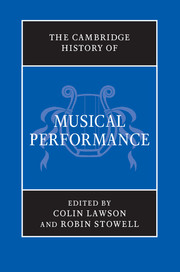Book contents
- Frontmatter
- PART I PERFORMANCE THROUGH HISTORY
- PART II PRE-RENAISSANCE PERFORMANCE
- PART III PERFORMANCE IN THE RENAISSANCE (C. 1430–1600)
- PART IV PERFORMANCE IN THE SEVENTEENTH CENTURY
- PART V PERFORMANCE IN THE ‘LONG EIGHTEENTH CENTURY’
- PART VI PERFORMANCE IN THE NINETEENTH CENTURY
- 24 Performance in the nineteenth century: an overview
- 25 Vocal performance in the nineteenth century
- 26 Instrumental performance in the nineteenth century
- 27 Case study: Richard Wagner, Tristan und Isolde
- PART VII THE TWENTIETH CENTURY AND BEYOND
- PART VIII
- Index
26 - Instrumental performance in the nineteenth century
from PART VI - PERFORMANCE IN THE NINETEENTH CENTURY
Published online by Cambridge University Press: 28 March 2012
- Frontmatter
- PART I PERFORMANCE THROUGH HISTORY
- PART II PRE-RENAISSANCE PERFORMANCE
- PART III PERFORMANCE IN THE RENAISSANCE (C. 1430–1600)
- PART IV PERFORMANCE IN THE SEVENTEENTH CENTURY
- PART V PERFORMANCE IN THE ‘LONG EIGHTEENTH CENTURY’
- PART VI PERFORMANCE IN THE NINETEENTH CENTURY
- 24 Performance in the nineteenth century: an overview
- 25 Vocal performance in the nineteenth century
- 26 Instrumental performance in the nineteenth century
- 27 Case study: Richard Wagner, Tristan und Isolde
- PART VII THE TWENTIETH CENTURY AND BEYOND
- PART VIII
- Index
Summary
1815–1848
Beethoven, Schubert and musical performance in Vienna from the Congress until 1830
As a major centre with a long tradition of performance, Vienna richly reflects the varied locations and types of performance in the early century. Following the Congress of Vienna, which had consolidated the position of Austria and especially Vienna within the German Confederation, there was a shift away from aristocratic patronage of music towards professionalisation, with work for musicians in theatres, churches or military bands. At the same time emerged the concept of a ‘Viennese School’ of Haydn, Mozart and Beethoven. Concerts took place in the Burgtheater, Kärntnertortheater and Theater an der Wien, as well as the larger Grosse Redoutensaal or Winterreitschule at the Hofburg Palace, the latter of which could seat at least 1,500 people, maybe as many as 3,000. Music was dominated by opera, especially the work of Rossini, but there were also major series pioneering instrumental music, organised mostly by members of the aristocracy in the Gesellschaft der Musikfreunde (hereafter the GdM), established in 1812, the Gesellschaft des Privat-Musik-Vereins, founded in 1818, and the Concerts Spirituels einer Gesellschaft von Musikfreunden, established in 1819. Audiences for these concerts constituted a genuine mixture of the upper and middle classes. There were also some more commercially oriented concerts, often featuring young virtuosi and private events in aristocratic salons.
- Type
- Chapter
- Information
- The Cambridge History of Musical Performance , pp. 643 - 695Publisher: Cambridge University PressPrint publication year: 2012
- 2
- Cited by



